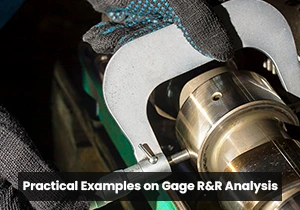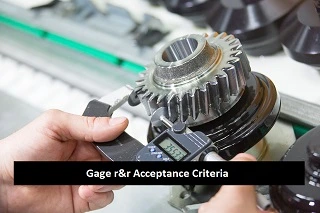The Complete Guide to Gage R&R: Ensuring Measurement Accuracy in Quality Management
Gage Repeatability and Reproducibility, often abbreviated as Gage R&R, is a statistical tool used in the field of quality control. In quality management, ensuring the accuracy and reliability of measurement systems is crucial. This is where Gage R&R (Gage Repeatability and Reproducibility) comes into play. It's a statistical tool used to assess how much of the variability in the data is due to the measurement system itself.
What is Gage R&R?
Gage R&R is part of the larger discipline of Measurement Systems Analysis (MSA), and it aims to assess the amount of variation in the measurements taken with a particular gage (or measurement system) that can be attributed to different factors. Simply you can say it is a collection of techniques used to evaluate a measurement system. It specifically measures:
- Repeatability
- Reproducibility
Repeatability refers to the variation in measurements taken with the same gage (measurement instrument) when used under the same conditions (same operator, same environment, etc.) over a short period of time. Reproducibility concerns the variation in measurements when different operators use the same gage to measure the same item.
Why is Gage R&R Important?
Gage R&R, short for Gage Repeatability and Reproducibility, is a critical tool in quality control for several less obvious yet highly significant reasons:
-
Enhancing Decision-Making Confidence: In manufacturing and quality control, decisions often hinge on measurements. If those measurements are unreliable, it can lead to poor decision-making. Gage R&R helps ensure that decisions based on measurement data are sound and dependable.
-
Facilitating Continuous Improvement: By regularly assessing the measurement system's performance, Gage R&R fosters a culture of continuous improvement. It's not just about finding faults; it's about constantly seeking ways to refine and enhance measurement processes.
-
Reducing Operational Variability: Variability is the enemy of quality. Gage R&R helps in pinpointing and minimizing variability in the measurement process, which is crucial for maintaining consistent quality in production.
-
Improving Supplier Relations: In supply chain management, having a reliable Gage R&R system can improve relationships with suppliers. It ensures that both parties are working with accurate and agreed-upon measurement standards.
-
Adapting to Technological Changes: As measurement technologies evolve, Gage R&R helps businesses adapt by providing a framework to assess new measurement tools and integrate them effectively into their processes.
Read More: 10 Principles Of Kaizen To Achieve Maximum Productivity
Types of Gage R&R Studies
Here are different types of Gage R&R studies, specifically Nested Gage R&R and Expanded Gage R&R:
Nested Gage R&R
Nested Gage R&R is used in situations where destructive measurement is involved. It requires each operator to measure entirely different sets of parts from each other.
Expanded Gage R&R
Expanded Gage R&R includes additional factors beyond the operator and part, such as different pieces of measurement equipment, test procedures, software, or environmental conditions
Steps in Conducting a Gage R&R Study
Gage R&R study is a crucial step in ensuring measurement accuracy in your quality control processes. Here are the foundational steps to guide you through a successful study:
1. Select the Equipment and Operators
Equipment : Beyond just picking measurement instruments, consider their history and usage patterns. Instruments that have been in service for longer may behave differently from newer ones, offering valuable insights into long-term reliability and maintenance effects.
Operator : When selecting operators, consider a mix of experience levels and possibly different shifts. This can provide insights into how training, fatigue, and other human factors affect measurement variability.
2. Plan the Study
Number of Parts: Choose a sufficient number of parts to represent the variation in your manufacturing process. These parts should cover the entire range of measurements you expect in normal production.
Number of Measurements: Decide on the number of times each part will be measured. This usually involves multiple measurements per part to assess repeatability.
Method of Data Collection:
- Part Selection Strategy: Instead of randomly selecting parts, consider choosing parts that have historically shown measurement challenges or variability. This targeted approach can help in addressing specific issues in the measurement process.
- Measurement Sequencing: Plan not just the number of measurements, but also their sequence. Sometimes, the order in which measurements are taken can reveal issues like instrument warm-up effects or operator fatigue.
3. Collect Data
Measurement Process: Each selected operator measures each part multiple times. The order of parts and operators should be randomized to minimize bias.
Recording Data: It's critical to record the data accurately. This includes noting which operator made which measurement and under what conditions, if they vary.
Points to Ponder
Environmental Factors:Document and control environmental variables like temperature, humidity, or vibration during data collection. These factors can subtly influence measurement results.
Anecdotal Observations: Encourage operators to note any difficulties or irregularities they encounter during measurement. These notes can provide context that numerical data alone might miss.
4. Analyze Data
Statistical Software or Spreadsheets: You can use specialized statistical software designed for Gage R&R analysis or customized spreadsheets. These tools will help you calculate the repeatability (variation in measurements taken by the same operator) and reproducibility (variation among different operators).
Key Metrics: The analysis will give you key metrics like the percentage of total variation due to measurement system variability, which is crucial for assessing the quality of the measurement system.
Points to Ponder
Beyond Standard Calculations:Look for patterns in the data that might indicate systemic issues, like certain parts always showing more variability or specific operators struggling with certain measurements.
Cross-Analysis with Process Data: If possible, correlate Gage R&R data with other process data. This can help identify if measurement issues are isolated or part of a larger process variability.
Calculation Method: When it comes to selecting a Calculation method for a Gage R&R study, there are three primary approaches, each with its unique applicability and complexity.
- Average and Range Method: This is a commonly chosen method, especially when utilizing spreadsheets for the analysis. It strikes a balance between accuracy and simplicity, making it a practical choice for many businesses. However, it's important to note that while this method is effective for spreadsheet-based analysis, it might not be the most efficient choice if you're employing specialized software.
- Range Method: This approach is more specialized and is typically employed in specific scenarios. It focuses on the variability within the measurements but may not always provide a comprehensive picture of the measurement system's performance.
- Analysis of Variance (ANOVA): The ANOVA method is the most comprehensive and effort-intensive of the three. It's particularly well-suited for use with dedicated statistical software or tools. ANOVA provides a deeper dive into the measurement system, analyzing the variance components in more detail. This method is highly recommended if you have the capability to leverage software tools for your Gage R&R study.
The choice of calculation method directly influences the interpretation of the Gage R&R results. Each method provides a different lens through which to view the data.
5. Interpret Results
Acceptability of the Measurement System: Based on the analysis, determine if the variability in the measurement system is within acceptable limits. These limits are often defined in terms of how much of the total process variation they represent.
Need for Improvement: If the measurement system is found to be a significant source of variability, you'll need to identify and implement improvements. This could involve better training for operators, maintenance or recalibration of equipment, or even replacing or upgrading the measurement devices.
Points to Ponder
Contextual Decision Making: When determining acceptability, consider the specific context of your production. What's acceptable in one industry or for one product might not be in another.
Actionable Improvements: If improvements are needed, focus on actionable and practical solutions.
Each of these steps, when conducted with attention to these detailed aspects, can greatly enhance the effectiveness of a Gage R&R analysis . This approach ensures not just statistical rigor but also practical applicability in improving the overall measurement system.
Read More: 5s principles - What Are The Five s's (5s) Of Lean
Interpreting Gage R&R Results
The results are often expressed as a percentage of the total variation:
- Less than 10%: Generally considered acceptable.
- 10% to 30%: May be acceptable based on the importance of the particular measurement and the cost/feasibility of improvement.
- More than 30%: Indicates significant issues with the measurement system.
Best Practices for Effective Gage R&R
- Regular Assessment: Conduct Gage R&R studies periodically or when changes are made to the measurement process.
- Training: Ensure that operators are adequately trained.
- Calibration: Regularly calibrate equipment.
- Data Analysis Skills: Develop proficiency in statistical analysis among team members.
Gage R&R is a fundamental tool for any organization focused on quality management. By ensuring the reliability and accuracy of measurement systems, organizations can make informed decisions, improve processes, and meet quality standards.Integrating Gage R&R with source inspections and quality control services further strengthens an organization's commitment to excellence, ensuring that every aspect of production meets the highest standards of quality and precision.


